| |
Mt Stuart, June 28-29, 2004
We had a grand plan: Climb the west ridge of Mt Stuart, and continue
east to traverse the ridge and summit Sherpa, Argonaut, Colchuck, and
Dragontail.
This time of year, enough snow was up there that water would not be a problem.
We could carry a minimal amount of bivy gear to minimize weight. Since
the climbing is rated 5.7 or below, we could move quickly and solo or
simul-climb most of the technical sections. That was the plan.
| We left Seattle at midnight on Sunday and departed
the Esmeralda
trailhead towards Ingalls Peak at 2:22am. We hiked quickly and confidently
past the first branch in the trail, waiting for the branch to Longs Pass. At
the second trail intersection: "Uhh, which way?"
| Following the edict of never consulting the map until one
is lost, we took
a peek and discovered that we had gone down Esmerelda Basin instead of Ingalls
Way. Instead of heading back 2+ miles and dropping down 1000 feet
pretty much to the trailhead, we chose a shortcut -- a slightly rising
traverse ENE to Ingalls Pass. The terrain looked open enough
not to cause too much difficulty. Aside from sidehilling on ball-bearings
for a few sections, the shortcut paid off. We rejoined
blindingly obvious tracks toward Ingalls Lake and continued
through Stuart Pass to the lower West Ridge.
| 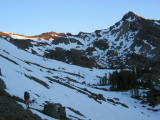
Gary hiking towards Ingalls Peak, Monday morning.
|
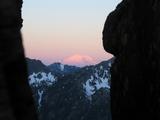
Rainier in the dawn light
| We soon enjoyed a view of Ingalls Peak to the north and a
glowing Rainier to the south.
| 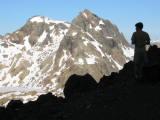
Gary looking back at Ingalls Peak
|
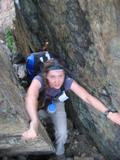
Ania, shortly before reaching Ingalls Pass.
| Pleasant steep scrambling took us higher. At some
point we decided
to put on helmets, disobeying the edict of not putting on the
helmet until the first rock comes down.
- "Oh no!"
- "What?"
- "One of my two water bottles is missing. It was in the outside
pocket and I must have forgotten to clip it to my packstrap. Good
booty for someone -- it had a Neutrino biner on it."
After a brief and futile glance to find the bottle, we continued up.
The rock steepened. To
the south, sandy ledges dropped slightly and traversed east. Toward the
north, the terrain looked more interesting and enticing. Northward, ho!
We finally reached a steep step that warranted a belay. After some
trundling, we each had a ledge barely suitable for putting on
harnesses and readying the rope and rack.
|
Gary led the first belayed pitch, roughly 5.9.
TCU in a crack to protect the belay. Grab jug with left hand,
swing with feet in the air, grab another jug with right hand.
Mantle, trying to use the feet somehow on the smooth overhanging face
below. Remind self to practice V0s in the gym with a 20-lb
pack...
"You're swinging like a monkey!"
The pitch eased off a little towards the top. Gary happily noted two
vintage Chouinard biners, which upon closer inspection turned out to be
"RECREATIONAL EQUIPMENT INC". Both are identical to the "LIBERTY USA 0"
biner we found later.
| 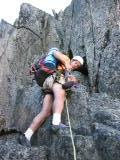
Gary starting to lead the first pitch, 5.9.
|
Our 2nd pitch descended down some loose and exposed but
easy ledges on the north side of the ridge
| 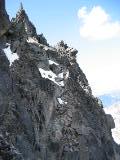
Looking back at the easy ledges of pitch 2.
|
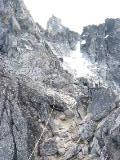
Looking up at the latter half of pitch 3.
| For our 3rd pitch, we simul-climbed directly up. Nearing
the top of the crest, a 50ft patch of steep snow lay along the most
straightforward and direct path. So much for keeping feet dry all day.
The snow was soft and rockshoes kicked good steps. Once past the crest,
ropedrag was bad enough that the best "anchor" and "belay" was just to walk
downhill on the sandy ledges on the less steep south side.
Two fellows from Yakima -- the only people we saw during the entire trip
-- were napping atop our 3rd pitch. Ania had briefly spoken to them near
the first belay. They had stayed further right (south) and ascended more
quickly on easier terrain (a.k.a. The Route). Without
bivy gear and concerned about the time, they rapelled down as we continued
up.
| 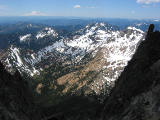
A pretty view, seen from pitch 3.
|
The 4th pitch was very short, due to rope drag. The 5th was a full 60m of
5.7 or 5.8, fun, zig-zaggy. To a large extent, though, many of our pitches
are just a blur in the mind -- a testament to just how much rock we climbed.
For that matter, counting pitches in the alpine is a somewhat arbitrary
affair. Our pitches varied in length from 20m to 200m, and difficulty
from 3rd class (it just wasn't worth the time to unrope) to 5.10a.
|
Nonetheless, occasional sections stand out. Example: pitch 6, a.k.a. the
belly-flop pitch. Piles of obelisks with the occasional
chockstone littered the line of weakness to a crest. Jam, yard on a
chockstone, squirm onto the ledge like a beached whale... why are mantles
so hard with packs? Squeeze between a huge flake and the rest of the
mountain. Another steep section, overhanging. Similar moves, and more
beached-whale action. The crest took a left turn here and ropedrag
potential did not look good. A short pitch, but a fun one.
|
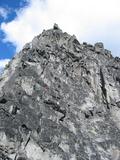
Looking forward at Ania about to place 1st piece.
|
Pitch 7, seemingly short and easy, turned out to be long and easy.
- "Do I need to protect the downclimbing for you?"
- "No."
- ...
- "Ok, this is ridiculous. I'm 40m out and haven't placed any pro.
I'm going to put in a piece."
| 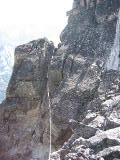
Looking back at Gary belaying.
| The terrain appeared easier so for pitches 8 and 9 we
short-roped and simuled. We initially stayed near the crest, enjoying
gendarmes and exposed moves similar to the traverse pitch on Prusik's
west ridge. Finally we dropped a little onto the south side. Sunset was
approaching. It was evident to both of us that time to bivy had come.
|
We were tired -- we'd been moving for the past sixteen hours. There was
a lot to get done before bedtime. Gary fetched snow and melted water. Ania
dug with her ice axe to flatten out a bivy spot and hung the tarp as a tent.
We ate, organized gear, and placed rocks on top of anything that might possibly
blow away in the night. Aside from the grit in our macaroni from the melted
snow, everything went quickly and smoothly.
Minimalist bivies are a far cry from the comfort of home. Since we expected
to be climbing with our packs, we opted to save weight. Neither of us had a
sleeping bag. Ania used her backpack as a sleeping pad. A thin
nylon sheet with tie-in points served as a tent.
| 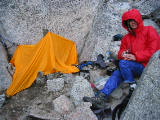
Tarp Sweet Home.
| We slept in late, getting up at 7 AM. We
needed the sleep and weren't really looking
forward to climbing on cold rock. Within an hour, we were ascending again.
Sandy ledges led south and around. We chose rock along the
crest and north face of the ridge, slightly more difficult and definitely more
fun. After a short unroped scramble, we tied in for 4 final pitches to the
summit.
|
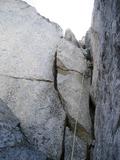
Short 5.10a crack, pitch 3 on day 2.
| The 3rd pitch of the day included a short but difficult
section,
5.9+ or 5.10a. We switched to belaying here. A large block lay between
two faces, creating two undulating cracks.
A mix of hand jams and chockstones for holds comprised our handholds.
One of the difficulties of
climbing in the alpine is that holds may be loose or shifty. Leader and
follower gingerly tested each hold, one foot jammed in the crack, the other
attempting to smear.
We ended the 3rd pitch only about 20m shy of the summit, with only one
moderately difficult move left for the final short pitch. With the
follower out of sight, ending early seemed safer than risking an
unintended simul-climb through the difficult section.
|
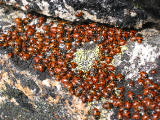
| Holy cow! Ladybugs! A phenomenon
experienced on only the other highest craggiest peaks. And this ain't
all of them...
|
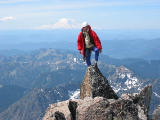
| 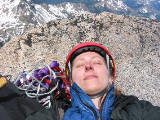
| We knew we weren't about to bag 4 more peaks to complete the
intended traverse. Ignoring the guidebook and choosing harder climbing had
made for more fun but also took more time. We took an hour to relax on the
summit, enjoy the views, take summit photos, and examine the traverse.
Next time, we'll do the north ridge. It's shorter.
| 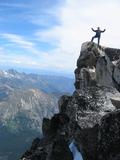
|
After a brief discussion of the merits of the Cascadian Couloir
(easier, but one false summit away) versus Ulrich's Couloir (underfoot),
we chose the direct route.
We began plunge-stepping down the soft snow.
One of us even demonstrated that self arrest does
indeed put an end to unintentional slides. The pick fully buried in
the snow and cut through like butter. Kicking the feet once slowed
the slide to a halt. We alternated down-climbing snow in self-arrest
position with plunge-stepping, depending on snow steepness and softness.
Some distance
down, the snow band narrowed and the raging stream beneath forced us to leave
the couloir proper. We traversed along rock but found ourselves at the edge
of a short cliff. "I was hoping not to do a rap on the descent. It would
have been so cool to climb this much rock and not have to rappel." But
alas. A sturdy horn of rock served as our 1st rap anchor.
| 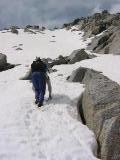
Descending snowy section of upper Ulrich's Couloir.
|
- "Woo-hoo!"
- "What?"
- "Look -- I found a water bottle!"
- "Does it have a name on it?"
- "Jenkins"
- "Does it have a neutrino biner on it?"
- "Aaaggh, don't ruin it for me."
|
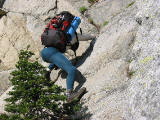
Gary downclimbing rock.
| We continued our descent. For speed and ease, we chose
snow over chossy scramble where possible. As we descend, the snow
narrowed and appeared weaker over the increasingly more powerful stream
beneath, so more and more we stayed on rock.
We got cliffed out again and rapped off a sturdy little tree. After yet
another short section of down-climbing, we came across an eerie sight:
an old white sling lying around a pile of broken rocks.
| 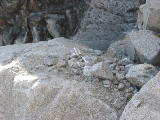
Someone's used rap sling?!
|
We squirmed past a tree to the left and carefully downclimbed
a steep 20ft wall.
- "This would be so much easier in rockshoes."
- "This would be so much easier without a pack."
This put us atop another small cliff. This time a tree with bleached
stiff rap slings greets us.
- "I don't trust any of these slings."
- "I don't either, but there's seven of them."
- "Rationally, that makes sense, but irrationally, it still makes me
uncomfortable."
Ania rapped first, with a fresh sling for backup. Armed with the empirical
evidence, Gary saved the sling and rapped off the old webbing. Funny how
climbers will risk so much just to save $2.
| 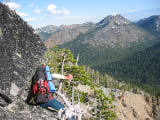
Gary squeezing past a small tree, just prior to our 3rd and
final rap.
|
Straight down, the terrain was scree, and even worse, the occasional
microwave block waiting to pounce. Although just a few hundred feet separated
us from timber, the terrain was just too unpleasant and dangerous. Instead,
we traversed and crossed the stream back to the west side of the couloir,
onto better rock. Exposed broken ledges gave way to a short downclimb next
to a tree and then easier terrain.
- "I found a helmet!"
- "Wow, it's heavy!"
- "I think I can use it as a flower pot."
Free of any dings, the helmet must have fallen off of someone's pack.
The helmet was dirty, filled with decomposing leaves and mud.
We tossed it in a plastic bag and lashed it to the outside of a pack.
|
The rest of the way down was uneventful. Timber led to meadows. We reached
the creek, glad to have avoided brush. Out of water, we filtered more until
the mosquitoes overcame our thirst. It was early evening, but we were
on the excellent trail paralleling Ingalls Creek so things looked good.
We headed west, occasionally glancing back at Stuart as its rock reddened.
| 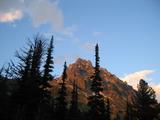
Mt Stuart turning pink in the light of the setting sun.
|
"Hey, I think we've gone too far. Long's Pass is over there."
The altimeter agreed that we'd gained too much altitude.
A shortcut seemed in order. Instead of backtracking and dropping down to
hit the turnoff, we cut directly west across meadows and scrambled up some
rock to emerge on the east side of Ingalls Lake. We could have walked
counterclockwise 3/4 of the way around the lake, or ascended steep slabs to
go over the knob on east of the lake. We're climbers, not circlers, so up we
went. It took us a few minutes, but we did find a section we could descend.
It felt slightly tricky with the vanishing light and in our tired state.
We saw some tracks roughly where the trail should be but they
vanished
shortly. We were tired. We'd been moving for 14 hours. Did we say we were
tired? Apparently, too tired to think straight, or to pull out the map. One
of us kept walking up, the other followed. On the map, unnoticed by us, the
trail followed contour lines. For us, the terrain steepened. "I'm too tired
to climb that slab in the dark safely." We finally descended, by moonlight
and headlamps.
Two hours later and not much closer to the car, we saw a trail. Excited,
we started to follow it.
- "Hold on. Are you sure we should be going this way?"
- "Yes."
- "But why is the trail dropping? And shouldn't it be heading in that
direction?"
We pulled out the map. Yes, we were on a trail, but not one on our map.
It was too dark to see the peaks clearly enough to identify them. We
couldn't figure out our exact location and we didn't know where the trail
went. Finally, we decided to bivy.
- "I can't seem to find a spot flat enough."
- "Neither can I."
- "What about this spot?"
- "There's nothing nearby to rig the tarp."
- "What about here? It's not that flat though."
- "I don't think I care any more."
Ahh, another minimalist bivy. I had wanted to find out how it would be
to spend a night out with just the extra warm clothes I bring along on
longer day hikes. But I didn't want to find out TWO nights in a row!
We put on all our clothes; filtered water; drank water; ate. We set up the
tarp; hid things from the snaffles; tried to sleep. An arm propped here to
keep from sliding or rolling over. A sore hip there.
- "Are you shivering?"
- "Oh, yeah. I didn't notice until you asked me."
Shivering can keep you from getting colder for a long time, apparently.
And Ania ought to replace her puffy jacket with a newer puffier one.
Eventually the skies brightened. We could see. Two hundred feet of walking
put us on the right trail. Two hours later we were back at the car.
There's no better feeling than getting the tired wet feet out of the
boots. Wait, there is. Stretching.
We drove back talking about trip. We consider it a success, though we
didn't accomplish our original plans of also bagging Sherpa, Argonaut,
Colchuck and Dragontail. If we were to do the west ridge again, we would
again choose fun rock over unaesthetic ledges. Although just maybe we'd
look at the map when on trail. Maybe.
The traverse still awaits, still entices.
To be continued...
|
Gear taken:
60m 9.4mm dry rope, rack of rock pro, rap slings, helmets,
1 ice axe each, 1 pair of crampons
to be shared (unused), stove, water filter, tarp
(for use as tent, no poles), warm clothes, food.
Gear lost:
1 Nalgene water bottle & Neutrino biner, 1 rap sling used for rap
Gear found:
1 Nalgene water bottle, 1 rap sling, 3 oval biners, 1 nut, 1 old
helmet
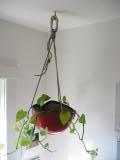
| Found gear, converted for use in a non-life-critical function.
|
All the photos. (This link may go away some
day.)
Some notes listing a summary of the pitches we
climbed, and a partial timeline.
A list of the food Ania brought.
© Anna Mitros
Back to Ania's Home Page
|





















